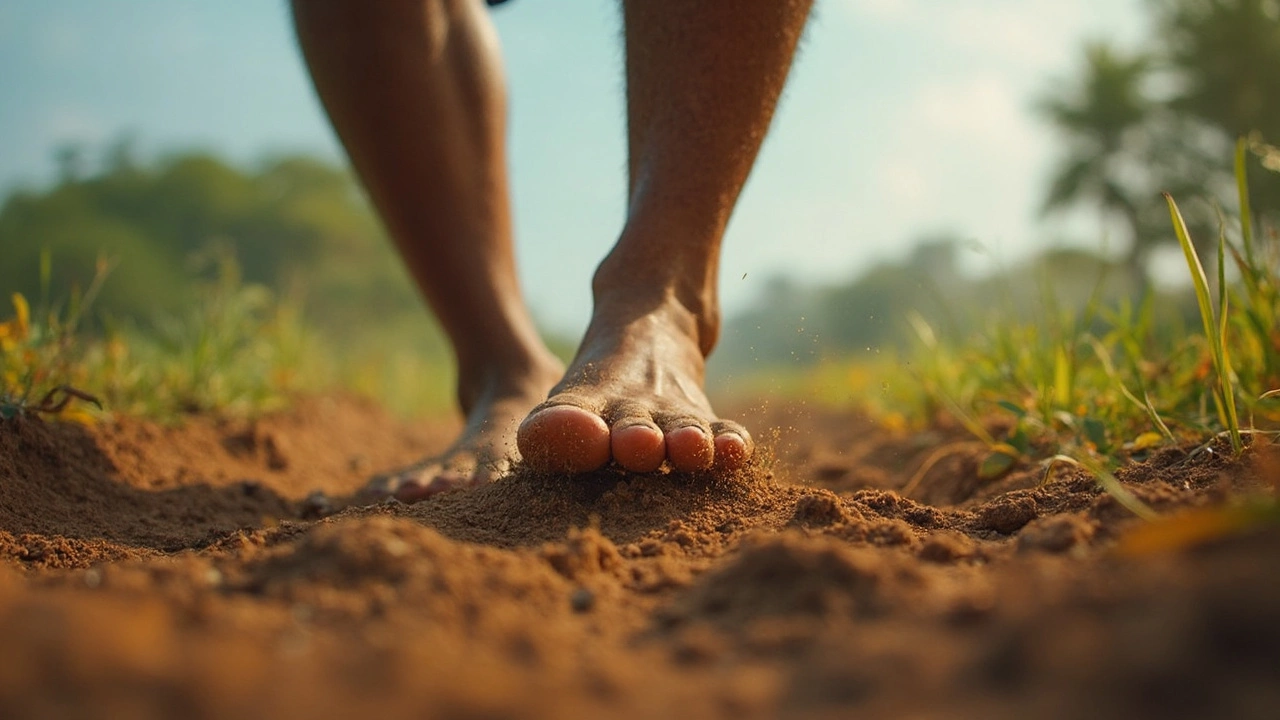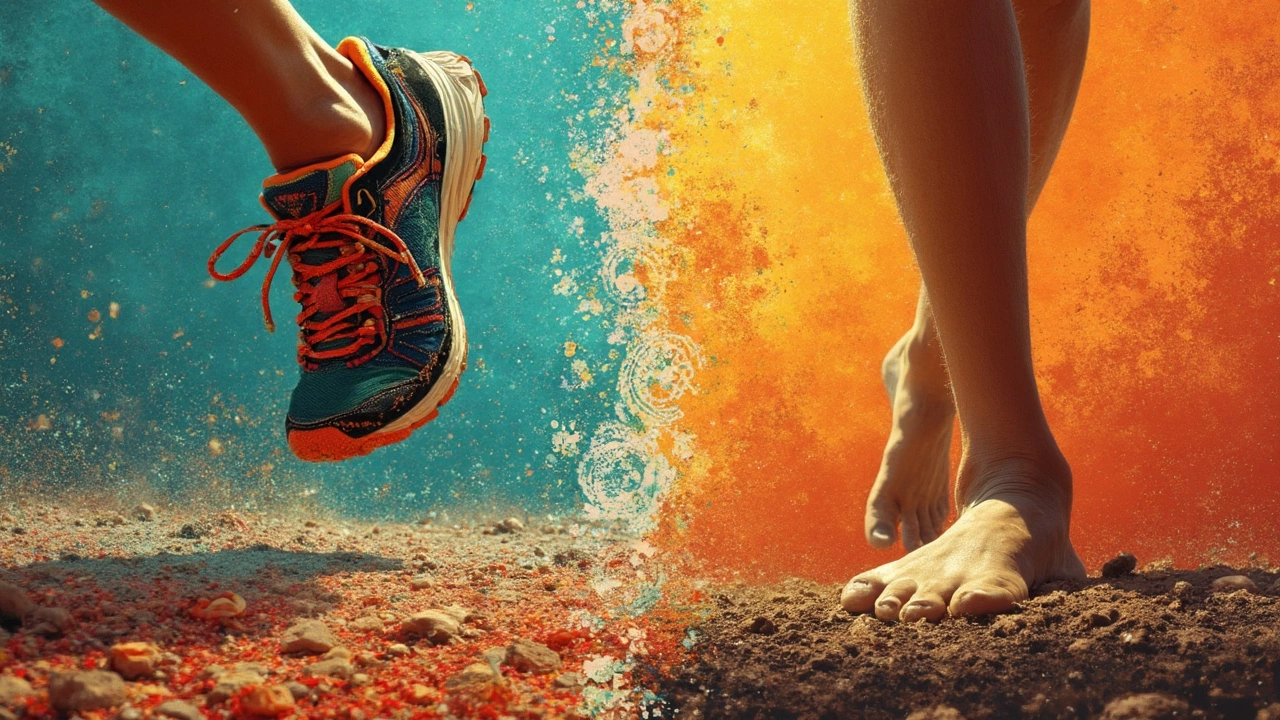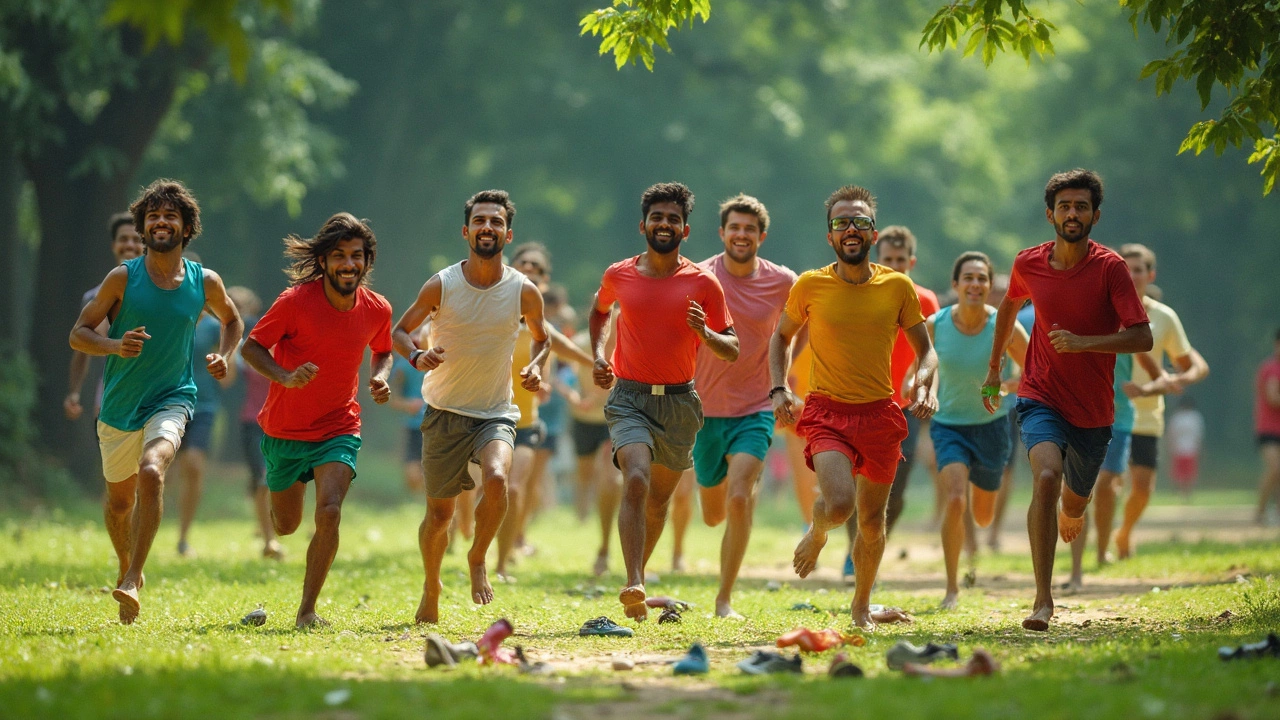Running barefoot might sound like a throwback to prehistoric times, but it's becoming a trend these days. Have you ever wondered why some runners are ditching their shoes and hitting the pavement sans footwear? Well, let’s unpack this fascinating shift.
There’s something about the natural feel of dirt under your feet and the minimalist vibe that attracts many. People argue that it's a more authentic way to run, connecting you directly with the ground. Plus, less gear to worry about, right?
But before you kick off your sneakers, it's a good idea to consider both the perks and potential pitfalls. While some swear by the freeing feeling and reported health benefits, there are also risks like injuries from stepping on sharp objects. Knowing how to ease into barefoot running can make all the difference. Stay with us as we dive deeper into how to scratch this curiosity safely.
- The Barefoot Appeal: Why Some Runners Love It
- Health Benefits: Is Barefoot Better for Your Body?
- Potential Risks: What You Need to Watch Out For
- Getting Started: Tips for Safe Barefoot Running
- Personal Stories: Real Runners Share Their Experiences
The Barefoot Appeal: Why Some Runners Love It
Ever tossed your running shoes aside and felt the earth beneath your feet? That’s what barefoot running is all about, and it’s drawing in a committed crowd. But what’s the big deal, anyway?
For starters, going barefoot means you get to run more naturally—some say it’s how our ancestors did it. The idea is that it allows your feet to move and flex as they naturally would, which can strengthen your feet and lower legs over time. It’s all about reconnecting with the way our bodies were meant to move.
Fans of barefoot running also claim it can help you tune into your body. It forces you to pay attention to your stride, engage different muscles, and shift your posture. These changes often lead to improved balance, better coordination, and even fewer injuries. Imagine a world where you’re less likely to get those pesky shin splints or knee aches.
Christopher McDougall, author of the bestselling book 'Born to Run', once remarked, "Shoeless is fearless... once you take off your shoes, you realize you're built to run."
Moreover, without the bulk of traditional shoes, barefoot running is often seen as a more freeing experience. The sense of lightness and the connection to the terrain can turn a simple jog into an adventure.
Some folks are even swapping to minimalist shoes that mimic the barefoot experience to ease into this shift. Want to take a stab at it? Start slow, listen to your body, and you might just unlock a new passion.
Health Benefits: Is Barefoot Better for Your Body?
The idea that barefoot running can bring health benefits might seem surprising. But advocates often highlight its potential to offer a more natural way to move and even improve some aspects of your physical health. So, is barefoot running really good for you?
First off, running without shoes may help improve foot and leg strength. When you run barefoot, it requires your feet and legs to engage more muscles because there's no cushioned shoe providing support. It’s like strength training, but for your feet.
Another point to consider is reduced injury risk. Many barefoot running fans argue that going without running shoes forces a more natural gait. Shoes can sometimes lead to a heavier heel strike, which sends jolts through your body. Without shoes, you're more likely to land on your forefoot or midfoot, lessening impact.
- Balance and proprioception: Running without shoes can help enhance these because your feet are in direct contact with the ground, forcing your body to adapt and improve stability over different surfaces.
- Flexibility: Your feet have the freedom to move unrestricted, improving flexibility and elasticity.
There is also a unique mental boost from running barefoot. Some runners report feeling more connected to their surroundings, like they're part of the landscape. This sensation can be refreshing and stress-reducing.
However, keep in mind that these benefits come if you choose to gradually transition into barefoot running. Your body needs time to adapt to the increased demand on your muscles and joints. Diving in too quickly can lead to injury, so proceed with patience and get ready to listen to your body.

Potential Risks: What You Need to Watch Out For
Running without shoes can sound like a blast, but it's not all smooth sailing. There are real risks that you definitely need to eyeball before hitting the ground barefoot. The first one that jumps out is the risk of cuts, bruises, or even more serious injuries from sharp objects, like stones or glass, lying sneakily on the path.
Next up, there's the issue of your feet not being used to all that direct contact with the ground. If you've spent years wearing cushioned running shoes, your foot muscles and tendons might need some time to adapt. Jumping right into barefoot running without preparing could lead to strained muscles or tendons.
Also, think about the surface you're running on. Asphalt can absorb heat from the sun, making it uncomfortable or even dangerous on a hot day. Opting for softer terrains such as grass or trails might reduce this risk but also watch out for uneven surfaces that might lead to ankle sprains if you're not careful.
- Inspect your path: Check your running route for potential hazards. A little recon can save you a lot of pain.
- Gradual transition: Slowly introduce your feet to barefoot running, giving those muscles and tendons time to adjust.
- Mind the temperature: Avoid running on hot pavements. Early morning or cooler paths are usually your friends here.
- Foot health: Pay attention to your feet’s condition after runs; signs of strain could mean it’s time to tweak your technique or pace.
Staying mindful of these risks can help you enjoy the awesome benefits of barefoot running while keeping those feet in one piece. Remember, safety first, so you can keep running for the long haul.
Getting Started: Tips for Safe Barefoot Running
So, you're thinking about giving barefoot running a try? Awesome choice, but let’s make sure you’re doing it safely. Jumping right into it might lead to unwanted blisters or injuries, so here's how you can ease into this natural style of running.
First off, start slow. Your feet aren't used to the bare ground, so it's crucial to transition gradually. Begin with short distances. Think of it like easing into a new pair of shoes, but even slower. Consider starting with ten minutes of barefoot walking, and then add five minutes at a time as your comfort grows.
Next, pick the right surface for those first few runs. Flat, soft surfaces like grass or sandy beaches are perfect starting points. Avoid rocky or uneven terrains until you’re more experienced.
- Strengthen your feet: Incorporate exercises to build foot muscles, like toe curls or picking up small objects with your toes. This will help your feet adapt quicker.
- Stay consistent: Practice regularly. Consistency helps build tolerance and conditioning over time.
- Listen to your body: If you experience soreness, back off a little. It’s your body’s way of telling you it's overstretching.
Many runners find that transitioning to barefoot can improve their overall running form too. The absence of cushioned shoes encourages a midfoot strike, potentially reducing the impact on joints. But always pay attention to your body. Comfort and safety over speed!
| Transition Time | Activity |
|---|---|
| Week 1 | 10 minutes walking barefoot |
| Week 2 | 15 minutes walking barefoot |
| Week 3 | 20 minutes walking barefoot + 5 minutes easy running |
If you do feel ready for barefoot running in public spaces, consider a pair of minimalist shoes for protection while keeping that natural feel. With these tips, you're on your way to a safer barefoot journey. Happy running!

Personal Stories: Real Runners Share Their Experiences
One might think running without shoes is just for the daring, but for some, it's a lifestyle choice that’s changed their outlook on running. Take Mike Sanders, for instance, a marathoner who swears that barefoot running helped cut down his knee pain and made him feel more connected to his surroundings. Mike says, "I feel like I enjoy each run more, savoring the sensation of every step."
Another dedicated barefoot runner, Sarah Holt, started running shoeless after reading Christopher McDougall's iconic book, 'Born to Run.' She shares, "What began as a whim to try something new quickly turned into a passion. I notice my posture has improved, and my feet feel stronger."
"The bare ground can teach us more than mile upon mile of shoe-walled roads ever could." – Christopher McDougall
Of course, not everyone has a fairy tale experience. Dave Thompson tried barefoot running after a friend recommended it, only to end up with bruised heels from not easing into it properly. He advises newcomers, "Take it slow. Your feet need time to build up the endurance."
To give you a clearer picture, here’s what some runners have noted:
- Improved balance and body awareness after a few months of adjustment.
- Initial aches in calves and arches can warm up eventually with consistent practice.
- Need for patience and proper technique rather than diving in headfirst.
And the stats show an interesting trend: according to a survey called 'Runners Insights 2023', about 21% of those who tried barefoot running noticed fewer injuries compared to traditional running. Of course, easing into it can play a big part in making this work for you.
When it comes to shoeless running, it's a mixed bag—rich with personal stories of triumph and trial. The key takeaway from these experiences? If you're curious, it's worth a try, but give your feet the time they need to adjust. Your journey will be your own story to share.
